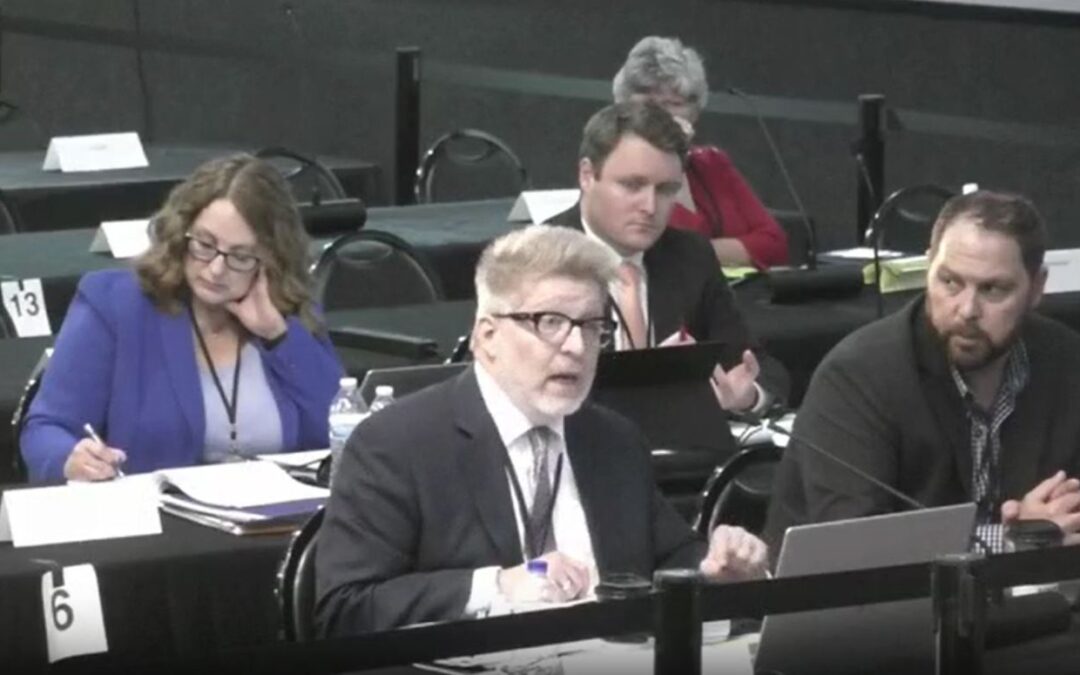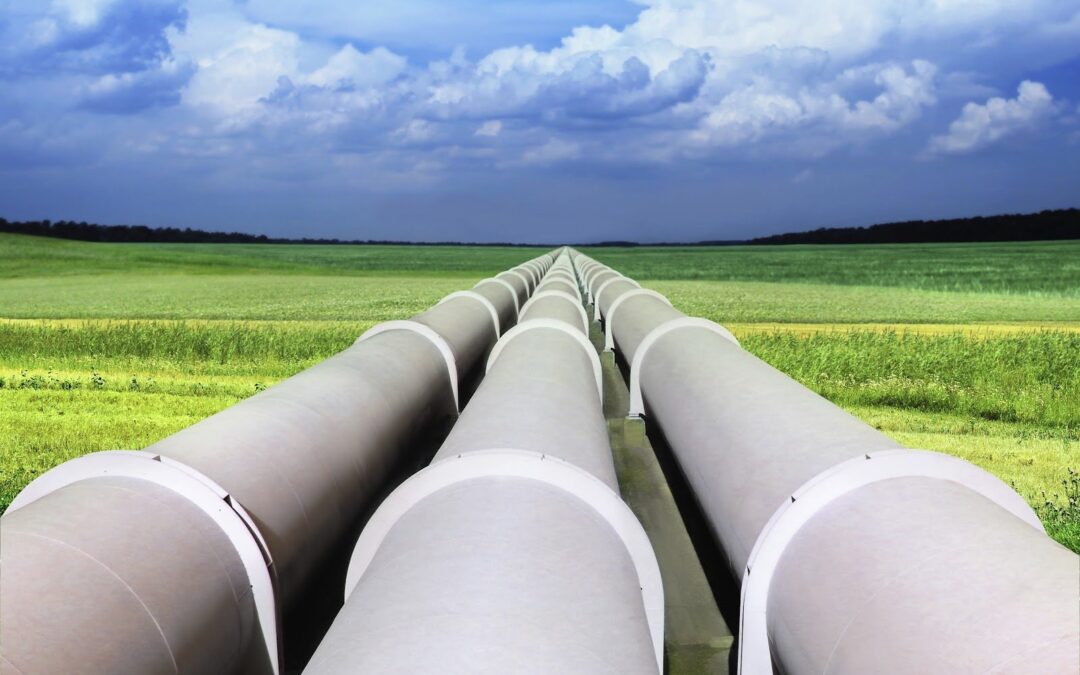
by Jordan Mason | Sep 1, 2023 | Archived
The Tazewell County State’s Attorney’s Office has filed a petition to intervene in Wolf Carbon Solutions’ pipeline construction application.
The petition comes two days after the anti-pipeline group Citizens Against Predatory Pipelines made a presentation before the Tazewell County Board. Concerned citizens also spoke against the pipeline, raising concerns about safety and eminent domain.
The pipeline would enter Tazewell County on the southern edge of Pekin and cut a southeastern path through the county en route to Logan County, and ultimately, a permanent underground sequestration site in Decatur. The high-pressure pipeline transports liquefied carbon dioxide captured from ethanol plants. Carbon capture and sequestration is touted as a measure to cut carbon emissions.
A petition to intervene doesn’t mean the county is taking a stance on the pipeline project. Rather, the petition keeps the county apprised of proceedings before the Illinois Commerce Commission regarding the process and allows the county to actively participate.
The city of Peoria has also filed as an intervenor. Peoria County hasn’t filed a petition to intervene.
The Illinois Commerce Commission is due to make a decision on the pipeline construction application by May 16, 2024.
We depend on your support to keep telling stories like this one. You – together with donors across the NPR Network – create a more informed public. Fact by fact, story by story. Please take a moment to donate now and fund the local news our community needs. Your support truly makes a difference.
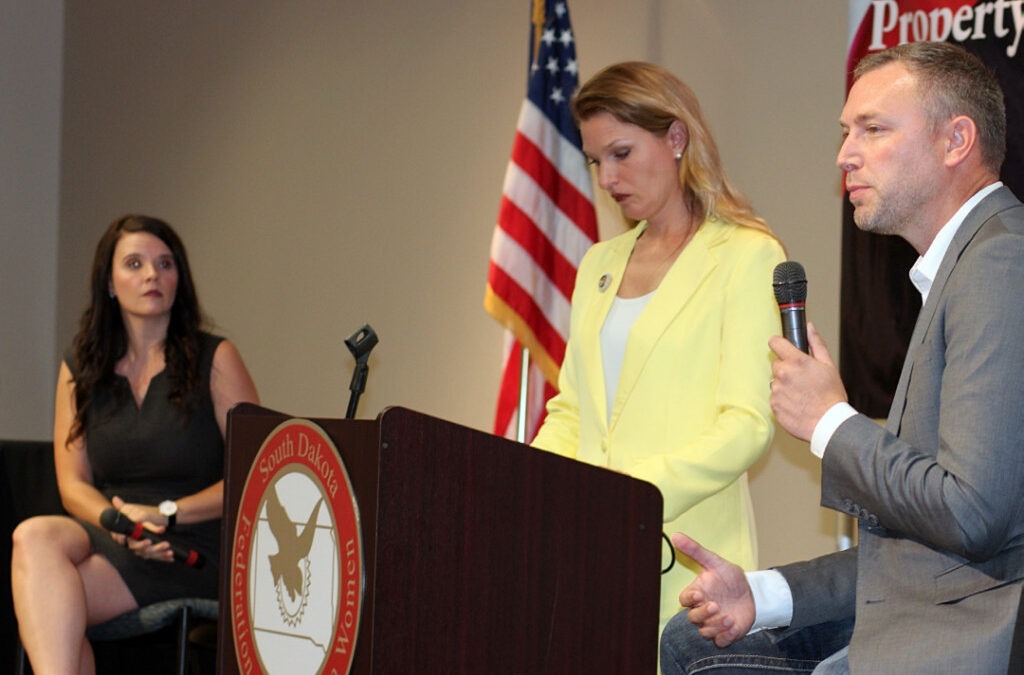
by Jordan Mason | Aug 25, 2023 | Archived
By: John Kubal, The Brookings Register
Updated: 3 hours ago / Posted Aug 25, 2023
BROOKINGS — The issue to be debated was “Property Rights & CO2 Pipeline.”
It was billed by the South Dakota Federation of Republican Women and the Sioux River Republican Women as a debate to “delve into the pros and cons, seek to inform but not to influence and to provide the public with as much information as possible in a fair and orderly manner.”
The venue was the Dacotah Bank Event Center, Brookings, on Tuesday evening. About 500 people were in attendance. The debaters were State Rep. Jon Hansen (R-Dell Rapids) and Elizabeth Burns-Thompson, Navigator CO2 vice president of Government and Public Affairs.
Sara Frankenstein, public relations chair of SDFRW served as moderator. Over the course of the 1-hour debate the key topics were government subsidies, safety and eminent domain, with an add-on brief look at “climate change.”
A coin toss had determined that Burns-Thompson lead off. In her very brief introduction, noting her first-generation ties to agriculture, she welcomed the “opportunity to start a dialogue.”
Hansen, a land owner and fifth-generation farmer, in his opening remarks cited government subsidies as “everything to this project. I would characterize this project as a boondoggle.
“This wouldn’t be happening without 45Q tax credit that’s funding the sequestration of carbon. That’s just the reality of it, folks. You might hear something different, but the reality is there’s no free market that’s driving this. This is being driven by massive federal subsidies.”
He added that “with a different administration that might change. I’d be grateful for a different administration, frankly. That would put an end to the 45Q tax credit and we could restore the free market. “
“I think we’re going to have our first opportunity to agree to disagree,” Burns-Thompson said in rebuttal. She noted that 45Q tax credits have been around since 2008 and were a product of the second-Bush administration.
“It was further expanded by the Trump Administration in 2018. It was expanded again in 2022.” She did admit that federal subsidies were “a driver” on CO2 sequestriation; but the market place’s biggest users of all types of fossil fuel products — such as California, Washington state, Oregon and Canada — are making investments tied to CO2 sequestration.
Burns-Thompson then pointed out the value of the various byproducts that spin off for corn growers in addition to ethanol itself — such as corn oil and distillers dry grain — and that an infrastructure needs to further grow to support those byproducts: “to further crack that last kernel.”
As to his supporting the additional byproducts tied the production of ethanol, Hansen cited his voting record during his eight years in the state House: he cast “not a single negative vote when it comes to ethanol. I’ve always been very pro ethanol. And I’ve always put ethanol in my gas tank.”
However, he noted that “when it comes to the future viability of ethanol, I think what we’re actually doing by following these policies that are set forth in California, Washington, Oregon and Canada … are going to long-term decimate, destroy the ethanol industry.”
He added, “Those policies that we’re chasing after in those markets aren’t free-market policies either. Those are sort of climate-crazed regulators and legislators in those jurisdictions that are setting these policies.”
Additionally, he noted that those states are looking at banning the sale of new combustion engines by 2035.
“Chasing those markets and appeasing those regulators is the last thing that ethanol should want to do. … It’s a terrible long-term strategy for ethanol. We should be defeating those policies.”
Sparring over safety
When the topic shifted to safety, Hansen did admit that in many situations, pipelines can be the safest mode of transportation. However, pressure is a big factor.
Hansen noted that natural gas moving in a pipeline exerts 500 to 700 psi. A carbon sequestration pipeline can exert 2,200 psi.
He explained that “plume studies,” that are key to safety issues of pipeline safety, have not been released to the counties that would have carbon pipelines running through them or been released to the public.
“Maybe Miss Burns-Thompson tonight will commit to disclosing them to the counties and to the people,” Hansen said. “I think that would be good.”
Burns-Thompson said that research shows that “pipelines are absolutely the safest and most reliable mode of transport, in large part because of the variables that are within our control, as compared to rail and trucks.” Moving CO2 moving via pipeline could replace a half-million trucks and 100,000 rail cars.
As to the release of plume studies data, she noted the need for security of some information being released because “there are some bad actors out there.” And there are some “homeland security concerns” not unique to CO2 pipelines but also applicable to infrastructure and other modes of transportation that preclude release of certain types of information.
“I think you just heard it,” Hansen responded. “Toward the end of my last response, I did ask Miss Burns-Thompson if she would be willing to release those plume models. That’s the most significant piece of information when it comes to your security next to that pipeline. They won’t release it; and they haven’t released it to the counties. I don’t think we’re too dumb to understand safety modeling.”
Eminent domain: Heart of the issue
Burns-Thompson was first to respond when the question shifted to voluntary cooperation versus eminent domain: “We want to do this project in as voluntary a fashion as is possible. Can I guarantee to you tonight that we can do every single mile of this without some application necessary … . No, I can’t make that commitment tonight. And I don’t think there has been a pipeline built that can make that pledge.” She did note that to date no application to use eminent domain has been made.
Hansen responded that the first page of a letter that Navigator CO2 sent to landowners said they “were already threatening to use eminent domain.”
He noted: “Eminent domain is the heart of the issue. … We talked about what is public use. The bottom line here is that this is not in the public use and should not be eligible for public domain.”
As to the going on to landowners’ property in violation of their rights, Burns-Thompson said, “We are trying to be accommodating as far as that survey work. … We are trying to follow not just the letter of the law.”
Burns-Thompson was also first to respond to a question about the impact of CO2
on “climate change” by the ethanol industry. “Regardless of your personal opinions — for, against, neutral, strongly — on climate change, you can still be a supporter of economic value … of what we are doing.” She added that “no one industry can solve the global problem.”
Hansen responded that while the Navigator project would be good for “capturing 45Q tax credits, it would do nothing for overall global temperatures. … This aint going to do anything.”
As the debate neared its end, he referenced a “leftist climate agenda … wasteful federal spending but I can’t get in the way. But it comes down to being voluntary. That’s what it’s really all about. Don’t take these peoples’ land without their consent.”
Any common ground?
The final question was: “Is there common ground between both positions and if so, where is it?” Burns-Thompson was first to answer. She did see things that were agreed upon: “Overall we want the Midwest to be successful. … Change is necessary. There is a right way to develop infrastructure: in a voluntary fashion; in a transparent fashion.”
Hansen responded: “I think if you did this voluntary and if you did it safely, I don’t think you’d see very many people in this room tonight. But when you start coming into South Dakota and try to take people’s land without their consent and subject them whether they like it or not to safety risks.
“That’s where the problem is. Commit to doing it voluntarily. We didn’t get that at tonight; we got the opposite. … Let’s be honest; they’re going to have to use eminent domain.”
In her closing statement, Burns-Thompson said she hoped this “was the start of a collective dialogue. I want to have a conversation.”
Hansen noted that Navigator CO2 was 84 percent owned by Blackrock, a multinational investment company out of New York City. “Some states won’t even do business with Blackrock because of some of their policies.” And 14 percent is owned by a fund out of the United Arab Emirate. Less than 2 percent is owned by South Dakotans and others.
His ending words: “And at the end of this, the landowners are going to prevail.”
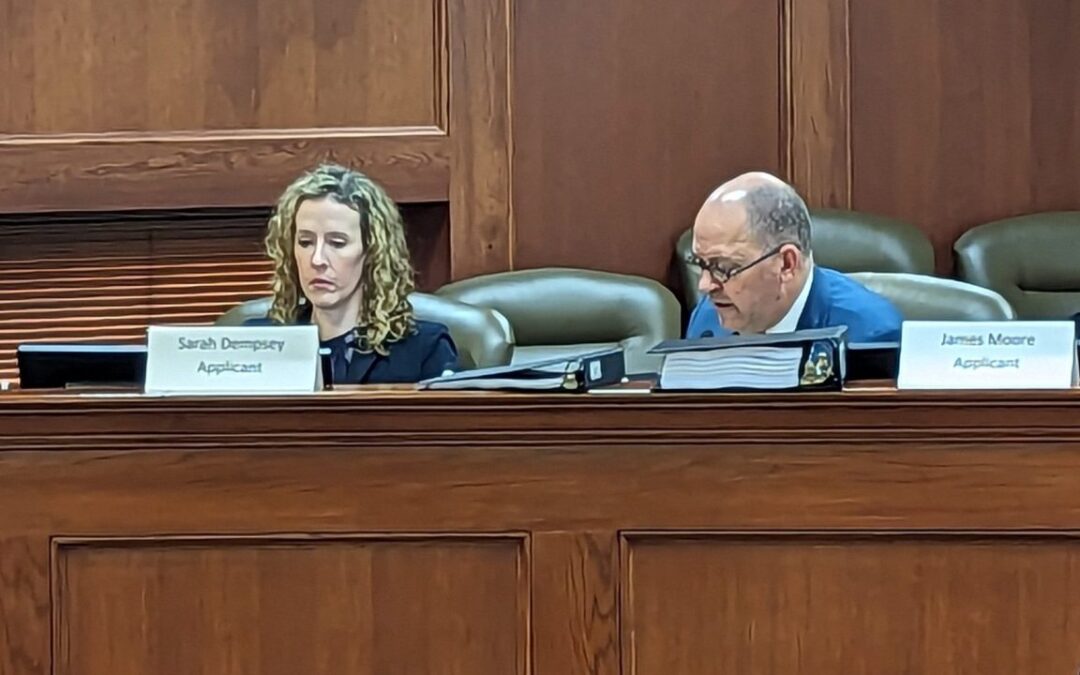
by Jordan Mason | Aug 25, 2023 | Archived
PIERRE, S.D. (KELO) — Top Navigator officials have reversed themselves and decided to let the public see a plume map showing potential effects from a rupture along the proposed route of the carbon-dioxide pipeline the company wants to build in southeastern South Dakota.
The state Public Utilities Commission on Thursday directed that the map be allowed as evidence and declared that it should be a public document, but also cautioned that it’s not yet accurate. The map shows the effects along the entire South Dakota portion of the route.
Commissioner Chris Nelson said the company must prepare and deliver a more-detailed map. “At that point, it should be released to the public,” he said.
The commission will decide on September 6 whether to grant a permit.
Commission chair Kristie Fiegen said the map that was offered Thursday presented only a partial picture of the possible effects. “It may not be the worst-case scenario. It isn’t,” she said.
Commissioner Gary Hanson favored releasing the map. He said people were “very leery” of the possible damage in the event of a rupture. “I think the more knowledge folks have, the better,” he said. He said that people would see the effects might not reach as far as many fear.
“There’s a whole lot more data that will be added to this,” Nelson said. He said the map shows that the effects wouldn’t stretch for “miles and miles and miles.”
Testifying for Navigator was Monica Howard, the company’s regulatory and environment vice president. She said the map was the visual representation of a lot of scientific information. Normally, she said, the information shown on the map was kept confidential for security reasons. “Creating them for public consumption is brand new to me,” she said.
The decision to offer to publicly release the map, if the commission directed it, was made at the company’s top level, Howard said.
Fiegen said the map didn’t reflect many variables. “I don’t want the public to have the wrong information, because we didn’t get all the information in your plume study,” Fiegen told Howard. “I guess that’s more of a comment than a question.”
The commission will decide either today or Friday whether to override pipeline zoning ordinances passed for Minnehaha and Moody counties. Navigator says the project can’t proceed if those ordinances stay in place.
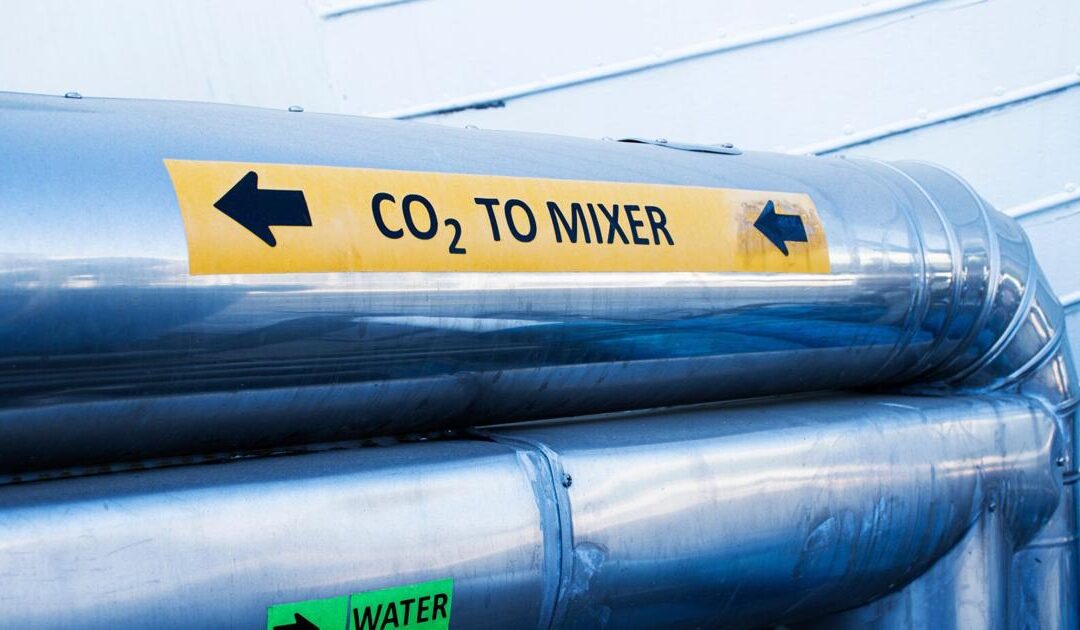
by Jordan Mason | Aug 25, 2023 | Archived
(The Center Square) – The Illinois Commerce Commission is considering a proposal to allow a Canadian company to build a CO2 pipeline through the state.
Wolf Carbon Solutions, the Canadian energy infrastructure entity with U.S. operations headquartered in Denver, filed its application with the Illinois Commerce Commission (ICC) June 16.
The pipeline would originate in Iowa, travel through the Quad Cities, then near Peoria, then on to Decatur. Archer Daniels Midland Company would serve as the pipeline’s “anchor customer” and be responsible for capturing CO2 emissions generated by its ethanol facilities in Iowa.
There has been some pushback from environmental groups, including from the Coalition to Stop CO2 Pipelines. Joyce Blumenshine, spokesperson for Sierra Club Illinois, said they are worried about safety because the proposed route runs close to homes and businesses in Peoria.
“For the public and people nearby, number one, and for the long term impacts to our prime farmland,“ Blumenshine told The Center Square. “We don’t have any idea what property value impacts might be.”
Blumenshine points to an incident in 2020 in Satartia, Mississippi, when a CO2 pipeline burst and sent dozens of residents to the hospital.
During a recent rally in Peoria, Jerry Briggs, a first responder at the Satartia incident, said it is important that all first responders, including law enforcement, understand the potential dangers of these pipelines
“First responders need recurring training, all communities affected by CO2 pipelines must have access to a mass notification system, and community members should be well informed. CO2 pipelines might be out of sight underground, but they can’t be out of mind,” Briggs said.
Gov. J.B. Pritzker said the legislature might get involved depending on the outcome with the ICC.
“I’m concerned that it will raise the prospect of safety challenges and raise the prospects of, as we’ve seen in other states, that if there is some sort of leak, that this could be a problem for all of Illinois,” Pritzker said.
Wolf Carbon Solutions reports in its application the project could generate an estimated $2.8 billion in economic impact across both Illinois and Iowa. A request for comment from the company was declined.
The ICC is also considering a petition from Nebraska-based Navigator CO2 Ventures to build 292 miles of the Heartland Greenway Pipeline System through Sangamon County in Illinois.

by Jordan Mason | Aug 22, 2023 | Archived
Not only does Summit Carbon Solutions want to take your land, but it also wants to take your water. The Iowa company, which wants to run a network of carbon dioxide pipelines across South Dakota to cash in on federal tax credits for carbon sequestration, wants to drill a well near Redfield and take 21 million gallons of water a year:
A corporate entity affiliated with Summit Carbon Solutions, called Redfield SCS Capture, has applied to drill a well that could take up to 21 million gallons of water per year from the Dakota Aquifer, which is an amount equivalent to about 32 Olympic-sized pools.
The well would be about 1,100 feet deep and located a few miles north of Redfield, in the same area as the Redfield Energy ethanol plant, which is a partner in the Summit pipeline project.
The state Department of Agriculture and Natural Resources said in a written statement to South Dakota Searchlight that the water will be used for “non-contact cooling.” The department provided no further information, and Summit did not respond to multiple Searchlight messages. Other sources interviewed for this story speculated the water will be used to cool pipes carrying pressurized carbon dioxide.
After its use, the water would be discharged into a local waterway, DANR’s report says. The report does not say which body of water, but the site is near Turtle Creek and the James River [Joshua Haiar, “Carbon Pipeline Company’s Water-Rights Application Sparks Opposition,” South Dakota Searchlight, 2023,08.20].
The state says that in 1982, the Dakota Aquifer had around 124 trillion gallons of water, enough to cool the carbon dioxide pipeline near Redfield for 5.9 million years. But some neighbors are concerned the project could hurt their water supply:
One of those nearby residents is Debra Curtis, who ranches about 2.5 miles from the proposed Summit well and fears it would “reduce the water pressure and flow of my well.”
Dave and Stacey Marlow wrote to the department that their drive-in theater “will not have adequate water pressure to continue business” if the project is permitted.
“I was told that much water being extracted will create a cone-shaped vacuum into the aquifer,” Dave Marlow told South Dakota Searchlight. “And for wells only a mile or so away, like ours, there’s just not enough pressure” [Haiar, 2023.08.20].
Concerned water users will get a chance to voice their opposition to Summit Carbon Solution’s well application before the state Water Management Board at a contested case hearing on October 4 in Pierre.

 The Tazewell County State’s Attorney’s Office has filed a petition to intervene in Wolf Carbon Solutions’ pipeline construction application.
The Tazewell County State’s Attorney’s Office has filed a petition to intervene in Wolf Carbon Solutions’ pipeline construction application.



